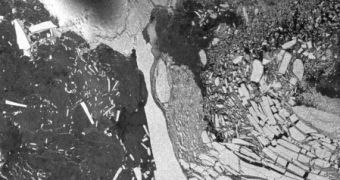The attention shifts again from the Arctic ice sheet to Antarctica as the European Space Agency's Envisat satellite showed how over the past month or so, a large ice sheet stretching between the Charcot and Latady Islands in the Antarctic Peninsula, known as the Wilkins Ice Shelf, started to break up again, for the second time this year and is expected to disintegrate altogether in the following years. Experts believe that the collapse of this bridge connecting the two islands is likely to trigger even more ice to break off from the shelf and melt into the ocean.
The Wilkins Ice Shelf has been stable for the most part of the last century, but started to break up again in the 1990s. The latest event came somehow as a surprise to researchers, as the Southern Hemisphere is currently in its winter season and the dynamics of the ice sheet seems to have changed in relation to the previous ice breakups.
"The scale of rifting in the newly-removed areas seems larger, and the pieces are moving out as large bergs and not toppled, finely-divided ice melange," said Ted Scambos from the U.S. National Snow and Ice Data Center.
Global warming appears to put more pressure on this particular part of Antarctica than on any other region in the hemisphere, experiencing a rise in temperature of 2.5 degrees Celsius in the last five decades alone. Scambos says that this is due to the fact that the Antarctic Peninsula is positioned between two regions that have increased their air temperatures significantly, but also due to rise in the temperature of oceanic waters.
"Wilkins Ice Shelf is the most recent in a long, and growing, list of ice shelves on the Antarctic Peninsula that are responding to the rapid warming that has occurred in this area over the last fifty years. Current events are showing that we were being too conservative when we made the prediction in the early 1990s that Wilkins Ice Shelf would be lost within thirty years - the truth is it is going more quickly than we guessed." said David Vaughan of the British Antarctic Survey.

 14 DAY TRIAL //
14 DAY TRIAL //